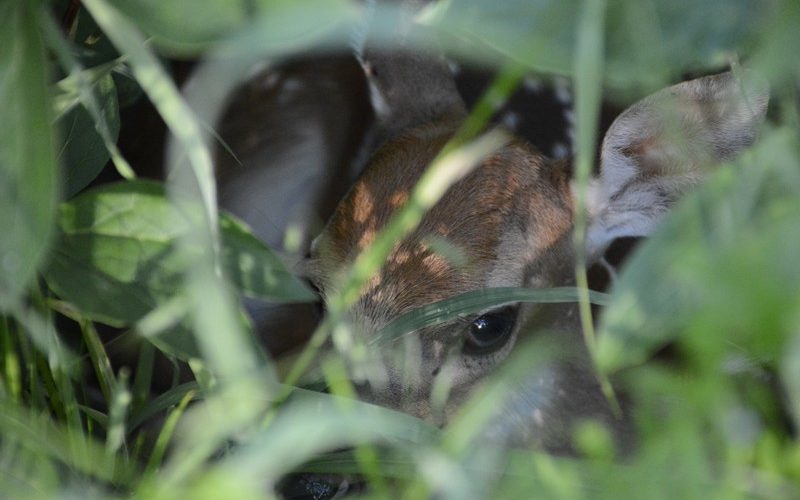Woodland creatures inspire rumination
AMANDA BANCROFT
Making Ripples
Sometimes it seems like yards are for growing grass and deer. White-tailed deer bound over Ozark mountains as though they were jumping over logs, and break through thorny brush like it were tissue paper. Often in flight from some real or imagined threat, they occasionally race for the sheer delight of chasing each other as children do. They hoof it across neighborhood streets on pencil-thin legs that seem hardly capable of carrying the bulky torso, thick necks, and large furry ears. Like wild ponies, they run together for safety and socialization, fluffy tails flying high and swishing back and forth with attitude as the back legs trot out a musical rhythm. These silent lawnmowers have more to their lives than aimless browsing. We can glimpse a bit of their view of the world, even if unable to penetrate the barrier between human and deer consciousness.
We may not see life as a deer does, but we think we know what they can and can’t see. Yellows and blues are more easily seen by deer than reds, which makes hunter orange (glaringly obvious to us) appear to blend in with the background. Deer are well-equipped to see in the dark, unlike humans. Our vision is weak at dawn and dusk, but these are the times when deer eyes can see best. To a deer, whose eyes do not adjust as quickly as ours to bright light in the darkness, a sudden glare of headlights is momentarily blinding. One minute a deer is browsing in the peace of night, fully capable of seeing its wild world, when suddenly a train of light bears down upon them and the world goes as blank as a piece of paper. Yet according to PBS Nature, a deer’s hearing is superb, and they can smell better than a bloodhound!
Seasonal cycles are immediate and inescapable; they have no hot cocoa by a cozy fireplace or iced sweet tea on a shaded porch. Changing weather, habitat, food and social relationships shape the lives of bucks, does, and their fawns.
In autumn, a buck is thrown into the tempest of the rut. He playfully sparred as a younger male, but the game becomes deadly serious once he reaches adulthood. His annual antlers grow at a rate of one inch every two days, making them the fastest growing tissue on earth (PBS Nature). The doe is not as docile as she seems. She must be aggressive, too. She exists in a hierarchy with higher-ranking females above her and lower-ranking females below and exerts her position by “hoofing,” or lashing out at her inferiors (sometimes injuring them).
The buck drops his antlers in winter and watches his donation to nature’s calcium pantry gnawed away to nothing by the woodland rodent crew. He doesn’t spend much time with the doe anymore. She carries new life within her and struggles to find enough food for two. She will eat anything from poison ivy to nestling songbirds to survive.
Springtime finds both the buck and the doe alive, thanks partly to humans engineering a world accidentally tailored to deer. Now, a third story begins: The doe gives birth in a secluded, secret spot, and must leave her newborn for long periods of time to protect it and feed herself. The fawn is accustomed to a solitary life in hiding, but what he thinks and feels, we do not know. Is he lonely? Is he excited, surrounded by myriad new playmates and discoveries? Fawns, like schoolchildren, must learn to look both ways before crossing a road. The old doe crosses carefully, followed by the skittish, start-stop prancing of her son. He pauses to gaze with interest at us. He’s so close we can hear his breathing, see his spotted sides heaving, nostrils flaring, as he grinds the grass in his mouth. Yet we can’t see his thoughts, or know why he walks closer to investigate, only to bound away as though chased by the devil.
In summer, the doe, her fawn, and the buck all hide during the afternoon to ruminate. Bedding down in fairy thickets, the doe and fawn vanish. The buck, adorned with velvet antlers, melts through the underbrush by following deer trails created by his great-great-grandeer. They must eat quickly while vulnerable to predation, then descend into a private world of digestion, close at hand but invisible. Do they ruminate on thoughts as well as food? We may never know.
Amanda Bancroft is a writer, artist, and naturalist living in an off-grid tiny house on Kessler Mountain. She and her husband Ryan blog about their adventures and offer tips to those wanting to make a difference at www.MakeRipples.org.










